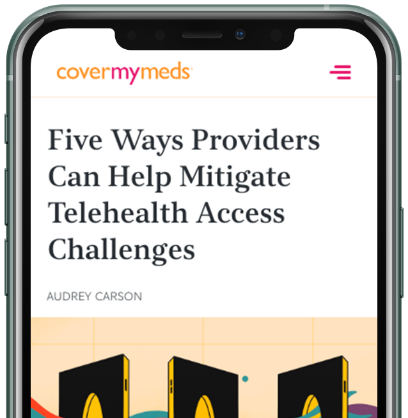6 Things Health Systems Need in Medication Access Technology
Health systems serve as the central nervous system of the healthcare ecosystem, sending critical signals that control voluntary and involuntary — but necessary — action. Physicians, nurses and administrative staff come together within physical and virtual walls to collaborate for better patient outcomes.

Each of these individuals needs to be connected to one another and the patient. This is where intuitive technology can help communicate necessary information so providers can make the best medication decision for each patient. Read on for a list of tools and features health systems should consider to support medication access.
Price transparency tools
With high-deductible plans rising — and 75 percent of patients never seeing the other side of their deductibleEmergency and Impact of Pharmacy Deductibles: Implications for Patients in Commercial Health Plans,” IMS Institute for Healthcare Informatics, September 2015 — price transparency is more important than ever.
Effective price transparency tools leverage an open network, free of bias, so patients can work with their provider to find the most affordable option. This may mean working within a deductible or pharmacy shopping outside insurance to find the best cash price.
Cash options outside of insurance
Mobile technology put the power of consumerism in people’s hands and that extends to prescription medications. While going through insurance can feel like the default method for accessing therapy, it is not the only choice. Providers and pharmacists can help patients understand their options and avoid sticker shock by sharing all options available at the patient’s preferred pharmacy.
Patient empowerment tools
Nearly every industry has needed to change and evolve to meet consumers’ changing expectations — healthcare is no different. In a recent survey, more than half of patients said they’d like easier access to their own records as one key healthcare improvement moving forward through the COVID-19 pandemic.CoverMyMeds COVID-19 Patient Survey, 2020
Many high-performing health systems and practices recognize the rise in patient consumerism and the demand for access to information and options, with affordability top-of-mind for most patients.CoverMyMeds COVID-19 Patient Survey, 2020 By tapping into an abundance of data available through prescription decision support solutions, and offering patient-facing solutions to view their own health data, patients can effectively become an active part of the care team.
Improvements in interoperability
By promoting open application programming interfaces (APIs), health systems can provide their clinicians with tools to better serve patients. These interfaces enhance the experience and allow patients to engage differently in their own healthcare. This can be especially helpful as telehealth settles in as a more permanent care option.
A clear mark of the industry shifting toward more patient data transparency was the passing of The Office of National Coordinator for Health Information Technology Cures Act Final Rule earlier this year, laying the groundwork for future API mandates while enabling data privacy and safety.What ONC’s Cures Act Final Rule Means for Patients, HealthIT.gov, 2020
Better telehealth experiences
A recent provider survey showed that 80 percent listed patients’ lack of technology skills as a significant telemedicine challenge.CoverMyMeds COVID-19 Provider Survey, 2020 But there are ways to improve this experience, matching the experience to what a patient would expect if they were in the office.
Often, the prescriber is the only healthcare professional with whom the patient will interact during a telehealth visit. Providers can benefit from access to an all-in-one prescription decision support solution. This is especially relevent as recent events have spurred changes in patient benefit status, how their medications are dispensed and ability to pay out-of-pocket. Sixty-five percent of patients surveyed have been financially affected by COVID-19.CoverMyMeds COVID-19 Patient Survey, 2020
Support for the entire care team
In a recent survey, 97 percent of nurses surveyed said they are giving medication information to their prescriber(s).CoverMyMeds COVID-19 Nurses Survey, 2019 Common examples include drug interactions, side effects, allergies, patient medication history, patient plan formulary information and prior authorization (PA) requirements.
Most are using multiple resources to find this important information because it has historically not been located through a single, trustworthy source. Nurses and care teams need information in a central location so they can easily access patient drug information while staying in workflow. Reliable, real-time solutions can empower the entire care team to work seamlessly to help patients get the medications they need — and stay on therapy.
Curious how medication access challenges directly impact your health system and what tools are in place or available? We invite you to explore our interactive website to see how these barriers may affect your patients and providers.
The latest healthcare insights, floated right to your inbox.





